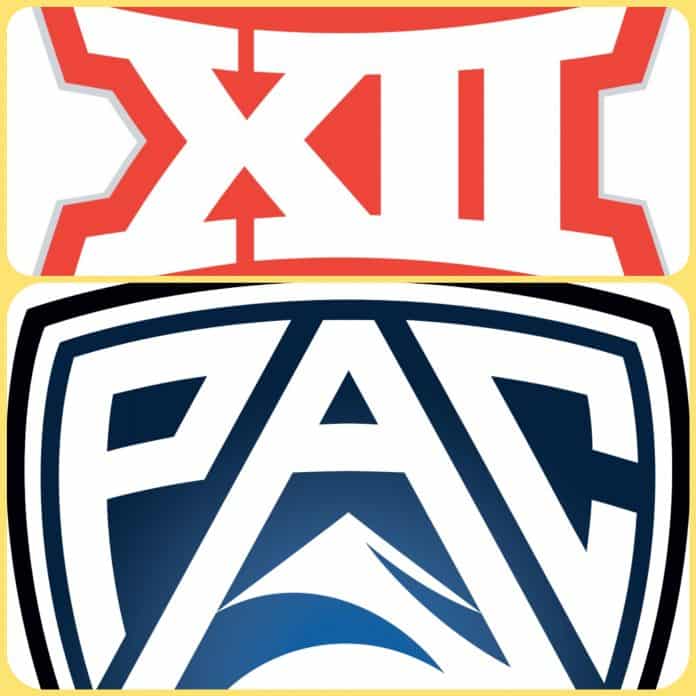
Part 1 of 2
The Big 12 has been on the receiving end of no shortage of criticism. Much of it deserved.
The biggest criticism leveled on the conference, from its inception in 1994, is its timidity. In the topsy-turvy world of college sports conference aggression, the Big 12 has ALWAYS been on the defensive. Sure, the conference could poach TCU and West Virginia from the dying Big East. But when it comes dealing with the big boys – the other Power 5 conferences – the Big 12 has always been the prey, never the predator.
Maybe that’s about to change.
In June 2010, more than a year before West Virginia announced its intention to join the conference, the Big 12 almost died. At the time the Pac-10 (now Pac-12) was in serious negations to pluck the conference’s crown jewels – Texas and Oklahoma – plus Oklahoma State, Colorado, Texas Tech and Texas A&M and add them to the West Coast league. Reports later confirmed that the move was all but finished before a change of heart by Texas put the kibosh on the prospective deal. The Big 12’s acquiescence on allowing Texas to operate its own television network (the Longhorn Network) led to Texas to stay in the Big 12 and save the conference.
The Big 12 would eventually still lose Colorado to the Pac-12, Texas A&M to the SEC and Nebraska to the Big Ten. The latter two opened the Big 12 door to TCU and West Virginia. After Louisville left the Big East to join the ACC in 2014 (replacing Maryland, which bolted for the Big Ten), the Power 5 football conferences have found a level of stability unseen in the past 30 years.
But in the dog-eat-dog world of intercollegiate conference realignment, if your conference isn’t the predator, it’s probably the prey. In 2016, the Big 12 flirted with the idea of expansion before eventually backtracking and deciding to stay at 10 teams. That foray again involved the Big 12 looking at Group of 6 conference teams as possible new members.
It’s possible next time the Big 12 goes looking for bigger game.
The Big 12 is in a solid place financially. The conference is third in revenue-per-team. It trails behind the biggest of the big boys – the SEC and Big Ten – but is competitive with the ACC and doing significantly better than the Pac-12.
On his recent podcast, The Athletic’s college sports guru Andy Staples praised the Big 12’s current leadership and talked about the possibility of the Big 12 turning the tables on the Pac-12 and stealing the best programs from the West Coast league for itself.
“The Big 12 is actually pretty well run, and it has a pretty good set of TV deals,” Staples said. “Not as good as the SEC and the Big Ten, but pretty good.”
Staples goes on to propose the Big 12 poach USC, UCLA, Arizona, Arizona State, Oregon and Washington and form a truly national 16-team mega conference. Current Pac-12 members aren’t happy with the current revenue situation in the conference, and they might be looking at non Pac-12 conferences as a means of improving it.
USC athletic director Mike Bohn expressed dissatisfaction with his school’s current revenue stream and said “everything is on the table” regarding USC’s conference future.
“There’s not talk of (leaving now), but guess what? If it was on the table, we would certainly explore that,” Bohn told CBS Sports.
This isn’t exactly a “no-brainer” of a situation, neither from the Big 12 nor the proposed new members.
For the Big 12, any expansion this large would need to bring with it A LOT more money via television deals to make it work. It’s possible that adding programs with the pedigree of USC and the others would generate the kind of TV-rights spike that makes the move profitable for everyone. But it’s not a guarantee that it would, either.
On the potential new schools’ side, this move would be a monumental shift in their athletic programs and disrupt a century of rivalries and partnerships. Would the increase profitability be worth the disruption? Would the state legislatures of California, Oregon and Washington allow the four schools from those states to leave their in-state brethren high and dry? What about the additional travel burden to both the schools and their fans? Is the money worth any and all these and other issues?
If the history of the cutthroat world of conference pilfering has taught us anything it’s that money talks and everything else walks. It’s also taught us that the Big 12 hasn’t shown itself to be a skilled hunter in this world.
There’s nothing that will likely change the former. But maybe the Big 12 is ready to change the latter.
Part 2: What would a mega Big 12/16 conference look like? How would it work? What would it mean for WVU?






